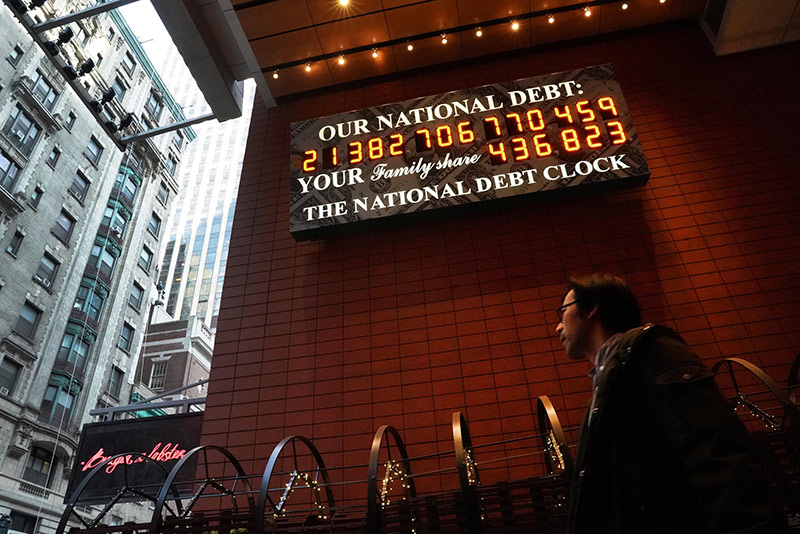关于美国债务上限,需要了解的五件事

|
正如《财富》杂志在今年4月所述,美国政府债务上限这个话题很有可能比今夏的天气还热。 终于,在众议院议长南希·佩洛西和财政部部长史蒂文·姆努钦会谈后,民主、共和两党看来很快就要达成协议,从而将政府债务触及上限的时间推迟到2021年7月。此举将永久性终结自动减支措施,将年度民用及国防开支总和提高3200亿美元,同时纳入7500万美元的开支抵销项,以便减少净赤字,使政府债务年增幅略有下降。 要跟上事态发展,大家就需要弄清楚下列问题。 什么是政府债务上限? 债务上限是政府控制美国负债规模的工具。建国后,美国的负债水平一直起伏不定。国会在很久以前就不得不对财政部的所有借款需求进行授权。 1917年美国正在为一战投入巨额资金,此时国会通过了改变债务管理方式的法案。财政部获得了一揽子授权,可以通过债券等多种方式举债,前提是负债总额在限定范围内。1939年,国会将这样的思路拓展到了美国的所有债务上。 从那时起,国会被迫多次提高债务上限,以便为政府借贷提供空间。 债务上限为何持续上升? 有两个原因。一是美国的支出一直高于其收入。2017年税法让这个问题的严重程度远远超过拥护者预期的水平,本财年(截至今年10月)美国的债务有可能再增加1.4万亿美元。 另一个原因是为原有债务支付利息。美国定期滚转现有债务,目的是维持大多数负债。随着利率上升或者债务增多,美国支付的利息总额也在增长。正如预算监测机构彼得森基金会指出的那样,按照国会预算办公室的估计,到2025年债务利息将成为美国政府预算的第三大单项支出。 我们为什么不停止借款以减少开支呢? 美国的债务并不是为了今后的支出,相反,它是以前的支出和财务负担,包括国家债务要支付的利息。 大家可以把国家债务想象成信用卡账户。政府计划开支,然后收到账单,包括利息在内。而政府的收入不足以支付到期款项,所以才要借钱。和信用卡不同的是,政府借款还要用于偿还以前的信用卡账单,所以美国的负债一直在上升。 如果不提高债务上限会怎样? 经济学家基本上都认为这会带来一场灾难,只是没有人能够确切预测会出现什么样的情况。一位前政府雇员曾经对《财富》杂志打比方说,那就像是在问全世界的核武器一起爆炸会怎么样。那会是人们无法理解的惨剧吗?还是说它会消灭所有的生命呢? 可能出现的情况之一是美元遭到挤兑,以及美元作为世界储备货币走向末路,全球市场崩溃,联邦政府债务利率将上升(同时对预算产生影响),政府工作人员和承包商以及享受社保、医保的人有可能再也拿不到钱。简单来说就是非常、非常糟糕。 所以债务上限问题会得到解决?对吧。 希望如此。大多数国会议员都不希望在这个问题上发生纷争,特别是在说不清楚谁会因此在政治上受益的情况下。新闻报道援引特朗普总统的话说,白宫和国会负责人进行了“非常好的对话”。但以前他面对协议时就曾经突然改变过主意。 同时,一些较保守的议员已经表示他们对削减开支的幅度不满意,而且当前协议在财政上是不负责任的行为。达到目的前他们会试图阻挠协议吗?也许吧。 时间不多了。9月30日前需要敲定预算,以便政府正常运转。此外,除了9月初部分违约,财政部也没有什么其他办法了,而国会也会很快在8月休会。 这也许一直是个热门话题,但愿较为冷静的头脑能够占据上风。(财富中文网) 译者:Charlie 审校:夏林 |
As Fortune noted in April, chances were good that the debt ceiling would become a hotter topic than the weather this summer. Finally, it's looking likely that following talks between House Speaker Nancy Pelosi and Treasury Secretary Steven Mnuchin, the parties are close to reaching a deal to extend the debt ceiling through July 2021, permanently end the sequester that can automatically cut spending, raise the combination of both domestic and military spending by $320 billion a year, and include $75 million in spending offsets to bring down net deficit spending so there's just a little less annual contribution to the national debt. Here's what you need to know to follow the developments. What is the debt ceiling? The debt ceiling is a tool government uses to control the amount of debt the country has. The U.S. has dealt with fluctuating debt since its inception. In the far past, Congress had to authorize borrowing by the Treasury for every need. In 1917—when the country was spending heavily on World War I—Congress passed a law to change debt management. The Treasury received blanket permission to undertake certain types of debt, like bonds, so long as the total stayed within set bounds. Congress expanded the concept in 1939 to cover all total U.S. debt. Congress has had to repeatedly increase the debt ceiling many times since then to accommodate the amount of borrowing the U.S. has undertaken. Why does the debt ceiling keep going up? There are two reasons. One is that the country keeps spending more than it takes in. The 2017 tax bill exacerbated the problem far beyond what its proponents projected, with the amount added this fiscal year (through October 2019) potentially adding another $1.4 trillion. The other reason is interest payments on previous debt. The U.S. periodically rolls over existing debt to keep most of the owed money outstanding. As interest rates rise, or debt grows, the country pays more total interest. As the budget watchdog Peter G. Peterson Foundation notes, interest on the debt will become the third-largest single "program" in the budget by 2025, according to Congressional Budget Office estimates. Why don't we end borrowing to reduce spending? The debt doesn't cover future spending but, instead, previous spending and financial obligations, including interest payments on the national debt. You can think of the national debt like a credit card account. The country plans spending and then the bills come due, including the interest. There isn't enough money coming in to cover what is due, so the government borrows. Unlike a credit card, the borrowing also occurs to cover previous credit card bills, so the amount keeps adding up. What would happen without a debt ceiling increase? Economists largely agree that this would be a disaster, although no one can predict exactly what would happen. One metaphor a former government staffer told Fortune is that it would be like asking what would happen if all the atomic weapons in the world went off at once. Would it be a tragedy beyond comprehension or, instead, would it wipe out all life? Some of the possible outcomes would be a run on the dollar, the end of the dollar as the world's reserve currency, global market crashes, interest rates on federal debt would raise (along with the impact on the budget), and potentially payments to government workers and contractors as well as Social Security and Medicare and Medicaid recipients could end. Let's just say it would be really, really bad. So, the debt ceiling will be fixed. Right? Hopefully. This isn't a fight most people in Congress want, especially as it isn't clear that it would benefit any of them politically. Reports quote President Trump as saying that the White House was having "very good talks" with congressional leaders. But he's suddenly changed his mind before on agreements. Additionally, some of the more conservative members of Congress have said they are unhappy with the level of spending cuts and that the current deal is not fiscally responsible. Might they try to block an agreement until they get what they want? Maybe. Time is running out. There needs to be some kind of budget deal by September 30 to keep the government open. Additionally the Treasury officially runs out of options beyond a partial default earlier in September, and Congress is quickly coming up on its August recess. It's may always be a hot topic, but hopefully cooler heads will prevail. |













